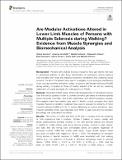| dc.contributor.author | Lencioni, Tiziana | |
| dc.contributor.author | Jonsdottir, Johanna | |
| dc.contributor.author | Cattaneo, Davide | |
| dc.contributor.author | Crippa, Alessandro | |
| dc.contributor.author | Gervasoni, Elisa | |
| dc.contributor.author | Rovaris, Marco | |
| dc.contributor.author | Bizzi, Emilio | |
| dc.contributor.author | Ferrarin, Maurizio | |
| dc.date.accessioned | 2017-02-21T19:05:39Z | |
| dc.date.available | 2017-02-21T19:05:39Z | |
| dc.date.issued | 2016-12 | |
| dc.date.submitted | 2016-07 | |
| dc.identifier.issn | 1662-5161 | |
| dc.identifier.uri | http://hdl.handle.net/1721.1/107007 | |
| dc.description.abstract | Background: Persons with Multiple Sclerosis frequently have gait deficits that lead to diminished activities of daily living. Identification of motoneuron activity patterns may elucidate new insight into impaired locomotor coordination and underlying neural systems. The aim of the present study was to investigate muscle synergies, identified by motor modules and their activation profiles, in persons with Multiple Sclerosis (PwMS) during walking compared to those of healthy subjects (HS), as well as, exploring relationship of muscle synergies with walking ability of PwMS.
Methods: Seventeen PwMS walked at their natural speed while 12 HS walked at slower than their natural speeds in order to provide normative gait values at matched speeds (spatio-temporal, kinematic, and kinetic parameters and electromyography signals). Non-negative matrix factorization was used to identify muscle synergies from eight muscles. Pearson's correlation coefficient was used to evaluate the similarity of motor modules between PwMS and HS. To assess differences in module activations, each module's activation timing was integrated over 100% of gait cycle and the activation percentage was computed in six phases.
Results: Fifty-nine% of PwMS and 58% of HS had 4 modules while the remaining of both populations had 3 modules. Module 2 (related to soleus, medial, and lateral gastrocnemius primarily involved in mid and terminal stance) and Module 3 (related to tibialis anterior and rectus femoris primarily involved in early stance, and early and late swing) were comparable across all subjects regardless of synergies number. PwMS had shorter stride length, longer double support phase and push off deficit with respect to HS (p < 0.05). The alterations of activation timing profiles of specific modules in PwMS were associated with their walking deficits (e.g., the reduction of Module 2 activation percentage index in terminal stance, PwMS 35.55 ± 13.23 vs. HS 50.51 ± 9.13% p < 0.05, and the push off deficit, PwMS 0.181 ± 0.136 vs. HS 0.291 ± 0.062 w/kg p < 0.05).
Conclusion: During gait PwMS have synergies numbers similar to healthy persons. Their neurological deficit alters modular control through modifications of the timing activation profiles rather than module composition. These changes were associated with their main walking impairment, muscle weakness, and prolonged double support. | en_US |
| dc.description.sponsorship | Italy. Ministry of Health | en_US |
| dc.language.iso | en_US | |
| dc.publisher | Frontiers Research Foundation | en_US |
| dc.relation.isversionof | http://dx.doi.org/10.3389/fnhum.2016.00620 | en_US |
| dc.rights | Creative Commons Attribution 4.0 International License | en_US |
| dc.rights.uri | http://creativecommons.org/licenses/by/4.0/ | en_US |
| dc.source | Frontiers | en_US |
| dc.title | Are Modular Activations Altered in Lower Limb Muscles of Persons with Multiple Sclerosis during Walking? Evidence from Muscle Synergies and Biomechanical Analysis | en_US |
| dc.type | Article | en_US |
| dc.identifier.citation | Lencioni, Tiziana et al. “Are Modular Activations Altered in Lower Limb Muscles of Persons with Multiple Sclerosis during Walking? Evidence from Muscle Synergies and Biomechanical Analysis.” Frontiers in Human Neuroscience 10 (2016): n. pag. | en_US |
| dc.contributor.department | Massachusetts Institute of Technology. Department of Brain and Cognitive Sciences | en_US |
| dc.contributor.department | McGovern Institute for Brain Research at MIT | en_US |
| dc.contributor.mitauthor | Bizzi, Emilio | |
| dc.relation.journal | Frontiers in Human Neuroscience | en_US |
| dc.eprint.version | Final published version | en_US |
| dc.type.uri | http://purl.org/eprint/type/JournalArticle | en_US |
| eprint.status | http://purl.org/eprint/status/PeerReviewed | en_US |
| dspace.orderedauthors | Lencioni, Tiziana; Jonsdottir, Johanna; Cattaneo, Davide; Crippa, Alessandro; Gervasoni, Elisa; Rovaris, Marco; Bizzi, Emilio; Ferrarin, Maurizio | en_US |
| dspace.embargo.terms | N | en_US |
| dc.identifier.orcid | https://orcid.org/0000-0002-7644-4498 | |
| mit.license | PUBLISHER_CC | en_US |
| mit.metadata.status | Complete | |
